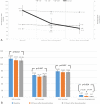Effects of Levosimendan on Systemic Perfusion in Patients with Low Interagency Registry for Mechanically Assisted Circulatory Support (INTERMACS) Score: Experience from a Single Center in Taiwan
- PMID: 34584384
- PMCID: PMC8414063
- DOI: 10.6515/ACS.202109_37(5).20210310B
Effects of Levosimendan on Systemic Perfusion in Patients with Low Interagency Registry for Mechanically Assisted Circulatory Support (INTERMACS) Score: Experience from a Single Center in Taiwan
Abstract
Background: Patients with cardiogenic shock have a high risk of mortality. Intravenous levosimendan can provide pharmacologic inotrope support.
Objectives: We aimed to investigate the effect of levosimendan in patients with extremely severe cardiogenic shock and low Interagency Registry for Mechanically Assisted Circulatory Support (INTERMACS) score with or without mechanical circulatory support.
Methods: From January 2017 to May 2019, 24 patients with INTERMACS 1-4 were enrolled in this retrospective study. All patients had systemic malperfusion and were treated with levosimendan. Biochemistry data related to systemic perfusion were recorded and compared before and at 24 and 72 hours after levosimendan administration. Echocardiography and Kansas City Cardiomyopathy Questionnaire (KCCQ) were completed 2 months later to assess left ventricular ejection fraction (LVEF) and quality of life (QoL), respectively.
Results: Arterial pressure and heart rate did not significantly differ before and after levosimendan administration. Atrial fibrillation and ventricular premature complex increased without significance. The dose of inotropes could be significantly tapered down. There were no significant differences in blood urea nitrogen, creatinine, and lactate levels. Urine output significantly increased (p = 0.018), and liver-related enzymes improved but without significance. B-type natriuretic peptide significantly decreased (p = 0.007) at 24 hours after levosimendan administration. Echocardiography showed significantly improved LVEF 2 months later (22.43 ± 8.13% to 35.87 ± 13.4%, p = 0.001). KCCQ showed significantly improved physical activity and greater relief of symptoms (p = 0.003). The survival-to-discharge rate was 75%.
Conclusions: We observed a decrease in B-type natriuretic peptide, better urine output, and alleviated hepatic injury in the levosimendan group. Most patients who survived without transplantation had significantly improved LVEF and better QoL after levosimendan administration.
Keywords: Cardiogenic shock; End-stage heart failure; Levosimendan; Systemic perfusion.
Figures


Similar articles
-
[Individualized use of levosimendan in cardiac surgery].Anaesthesist. 2021 Mar;70(3):204-212. doi: 10.1007/s00101-020-00860-0. Epub 2020 Oct 1. Anaesthesist. 2021. PMID: 33001236 German.
-
INTERMACS (Interagency Registry for Mechanically Assisted Circulatory Support) Profiling Identifies Ambulatory Patients at High Risk on Medical Therapy After Hospitalizations for Heart Failure.Circ Heart Fail. 2016 Nov;9(11):e003032. doi: 10.1161/CIRCHEARTFAILURE.116.003032. Circ Heart Fail. 2016. PMID: 27834198
-
[Effects of levosimendan on hemodynamics and cardiac function in patients with septic shock].Zhonghua Wei Zhong Bing Ji Jiu Yi Xue. 2014 Oct;26(10):692-6. doi: 10.3760/cma.j.issn.2095-4352.2014.10.002. Zhonghua Wei Zhong Bing Ji Jiu Yi Xue. 2014. PMID: 25315937 Clinical Trial. Chinese.
-
Levosimendan Can Improve the Level of B-Type Natriuretic Peptide and the Left Ventricular Ejection Fraction of Patients with Advanced Heart Failure: A Meta-analysis of Randomized Controlled Trials.Am J Cardiovasc Drugs. 2021 Jan;21(1):73-81. doi: 10.1007/s40256-020-00416-y. Am J Cardiovasc Drugs. 2021. PMID: 32462455
-
Effects of levosimendan on weaning and survival in adult cardiogenic shock patients with veno-arterial extracorporeal membrane oxygenation: systematic review and meta-analysis.Perfusion. 2020 Sep;35(6):484-491. doi: 10.1177/0267659120918473. Epub 2020 May 24. Perfusion. 2020. PMID: 32449494
Cited by
-
Levosimendan in intensive care and emergency medicine: literature update and expert recommendations for optimal efficacy and safety.J Anesth Analg Crit Care. 2022 Jan 24;2(1):4. doi: 10.1186/s44158-021-00030-7. J Anesth Analg Crit Care. 2022. PMID: 37386589 Free PMC article. Review.
References
-
- van Diepen S, Katz JN, Albert NM, et al. Contemporary management of cardiogenic shock: a scientific statement from the American Heart Association. Circulation. 2017;136:e232–e268. - PubMed
-
- Pollesello P, Ovaska M, Kaivola J, et al. Binding of a new Ca2+ sensitizer, levosimendan, to recombinant human cardiac troponin C. A molecular modelling, fluorescence probe, and proton nuclear magnetic resonance study. J Biol Chem. 1994;269:28584–28590. - PubMed
-
- Sorsa T, Heikkinen S, Abbott MB, et al. Binding of levosimendan, a calcium sensitizer, to cardiac troponin C. J Biol Chem. 2001;276:9337–9343. - PubMed
-
- Papp Z, Édes I, Fruhwald S, et al. Levosimendan: molecular mechanisms and clinical implications: consensus of experts on the mechanisms of action of levosimendan. Int J Cardiol. 2012;159:82–87. - PubMed
LinkOut - more resources
Full Text Sources
